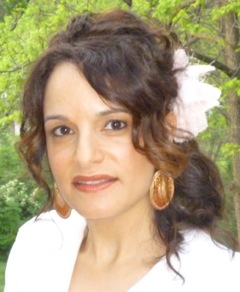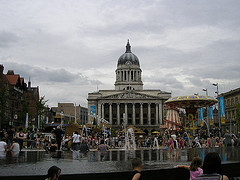Literary Boroughs #33: Laramie, WY
The Literary Boroughs series will explore little-known and well-known literary communities across the country and world and show that while literary culture can exist online without regard to geographic location, it also continues to thrive locally. Posts are by no means exhaustive and we encourage our readers to contribute in the comment section. The series will run on our blog from May 2012 until AWP13 in Boston. Please enjoy the thirty-third post on Laramie, Wyoming, by Caleb Johnson. -Andrea Martucci, Ploughshares Managing Editor
Laramie is named after Jacques LaRamie, a French-Canadian trapper who went into the mountains after beaver pelts one day in the early 1800s and never returned. Some say a bear ate him. Others say Arapaho Indians killed him and stuffed his body into a beaver dam. Whatever end LaRamie ultimately met, he disappeared without much of a trace.
Laramie still feels like that kind of place, too. A place where you can disappear. It is isolated, situated on a wide plain in southeastern Wyoming between granite hills to the east and taller mountains with snowy peaks to the west. There is so much space, so much quiet; a writer’s dream.
Today, Laramie is a quaint town of almost 30,000 people with the state’s only university, a couple independent bookstores, coffee shops and several fine local restaurants. The former tent city might be unrecognizable to LaRamie, but, if you look closely, the past is always present in this modern-day rail town.
What the city is known for/what makes it unique:
Outdoor recreation, including hiking, skiing/snowboarding, fly-fishing, rock climbing, hunting; nearby Woods Landing, a dancehall built on top of 24 rail-car box springs and placed on the National Register of Historic Places; the University of Wyoming; incessant winds; beautiful (yet short) summers; long and cold winters.
Resident writers:
Owen Wister wrote the first western novel, The Virginian, just outside of Laramie in Medicine Bow, where is a 100-year-old hotel named after the novel. It makes a unique writing retreat for anybody willing to take a short drive from town. Ernest Hemingway stayed at the historic Cooper House on UW’s campus. Rumor has it, Richard Cooper, the son of the house’s original owners, asked Hemingway to sleep on the first floor so he wouldn’t fall down the stairs – likely while drunk. Pulitzer-prize winner Annie Proulx lives on a ranch just across the Snowy Range from Laramie, near the town of Saratoga, which is known for its natural hot springs.
Today, Laramie’s writer residents include, but are not limited to, Brad Watson, Alyson Hagy, H.L. Hix, Kate Northrop, Joy Williams (part-time), Beth Loffreda, Mark Jenkins, Andy Fitch, David Romtvedt, Jeff Lockwood, Danielle Pafunda and Rattawut Lapcharoensap, as well as a rotating group of MFA in creative writing students each year.
Literary references:
From the collection Ghosts of Wyoming to the recent novel Boleto, much of Alyson Hagy’s recent work is set in Wyoming. My Friend Flicka, the 1941 novel by Mary O’Hara, which later became a film, was written on a ranch between Laramie and Cheyenne. David Romtvedt is a former Wyoming Poet Laureate and often writes about The Equality State. Annie Proulx has a collection of Wyoming stories, Close Range: Wyoming Stories, which includes “Brokeback Mountain.”
Where to learn:
The University of Wyoming’s MFA in creative writing program has quickly risen through the annual rankings released by Poets & Writers magazine, securing a spot in the top 85 full-residency programs in the 2013 edition. The program’s low student-to-faculty ratio and flexible curriculum really can’t be beat, if you ask me. (Of course, I’m partial.) The program brings many writers to Laramie for public readings on campus and at local bookstores, and for brief stays in town, which further fosters the literary community and is fitting for a town built upon transience.
Where to find reading material:
Second Story Books is Laramie’s independent bookstore. As the name implies, it is on the second story of an old building downtown. The store is well stocked with many independent releases and some best sellers. The staff is always happy to order something they don’t have in stock as well. Its neighbor, Night Heron Books, is a used bookstore where you can find yourself wasting entire afternoons browsing the crowded shelves, and sells great coffee, food and snacks. Bart’s Flea Market can also provide the occasional second-hand treasure. Go there to look at all the crazy, old junk—taxidermy, old hats, typewriters, and vinyl records—if nothing else.
Where to get published:
The Owen Wister Review is an undergraduate student-run journal at the University of Wyoming. Other than that, it’s up to local writers to send their work out into the wide-world beyond our small town.
Where to write:
Climb the narrow staircase and sit upstairs at Night Heron Books, where you can write while staring out the same windows men did after a rendezvous with one of the many sporting ladies who once called downtown Laramie home. One block over is Coal Creek Coffee Co., which features tall windows and numerous tables. The coffee shop also hosts an open-mic night the first Wednesday of each month, if you’re looking for a place to test your work on a crowd.
During the short summer, walk or bike to one of Laramie’s many beautiful parks. Bring a blanket, spread it on the grass and write or read until the sun fades in the west and a chilly wind sweeps through town rattling the big, old cottonwood trees. Washington Park even has a stage with a whitewashed orchestra shell if you really want to get in a composing mood.
Front Street bar faces the railroad tracks, which run north/south through town. It can be blindingly bright here when the sun is setting, but it’s worth it to sit and watch Union Pacific freight trains roll past while you write and enjoy a cold drink. The Buckhorn Bar is listed on The National Register of Historic Places. Grab a comfortable booth here looking out onto Ivinson Avenue. The full-length mirror behind the bar at The Buck, as it is affectionately called, has a bullet hole left by a man who loved and was rejected by a bartender. This was in 1971; hardly during the old Wild West as you might think.
Events/Festivals:
UW MFA students host a First Friday Reading Series each month at different locations around town. Second Story Books hosts author readings and book signings from time to time. The UW English department and the MFA program also host literary events on campus throughout the year.
The Equality State Book Festival takes place in different locations around the state each year. This year’s festival was held in Casper in mid-September. The two-day event is worth a drive, which Wyoming residents don’t think twice about in such a spacious state.
Caleb Johnson was born and raised in northwest Alabama. He studied journalism at The University of Alabama and is currently an MFA candidate in fiction at the University of Wyoming.
All photos courtesy Irina Zhorov.


